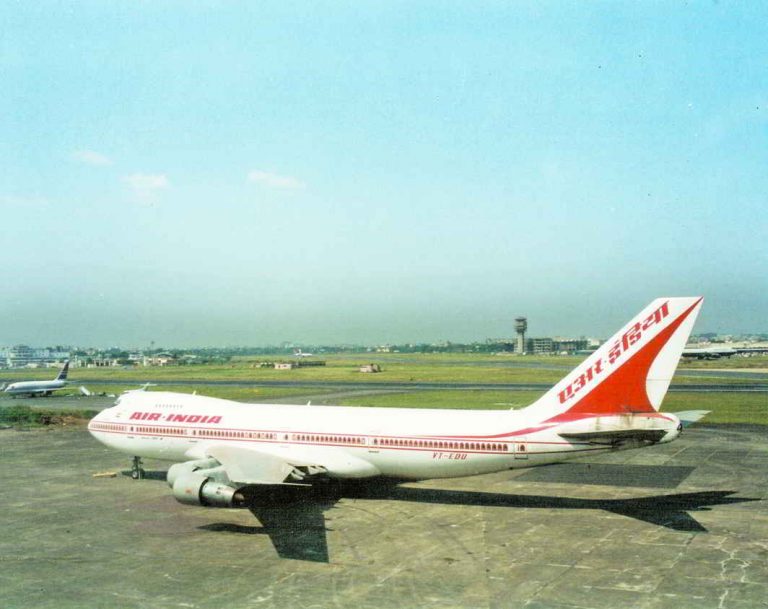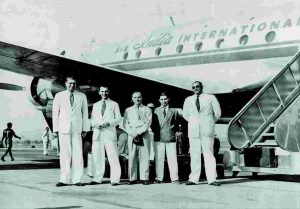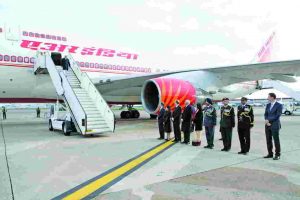
With the fortunes of this once-glorious airline plunging rapidly and the centre in no mood to aid it further, the blame has to be shared by politicians, bureaucrats and the staff

~By Jitender Bhargava
Air India has, for a change, been in the news for the right reasons for two unrelated developments. One is the CBI filing three FIRs for instituting probes into decisions that financially incapacitated Air India and the other is the government finally waking up to address the question of its future through strategic disinvestment.
Both issues have raised questions along expected lines because of the abysmal track record of government inaction. Will these issues be pursued to the logical end with the government exhibiting adequate determination and not sacrificing it at the altar of political expediency? And why have the CBI and government suddenly woken up from slumber to take up these issues which had been crying for attention for years now?
These cynical reactions have emanated because of Air India’s plunge from the heights it once commanded to its current pitiable state, which has been the consequence of gross inaction on the part of the government.
The diminution of a national carrier that was once a globally recognised brand can be akin to an airline descending from a safe altitude of 30,000 feet with the chairman and board members seated in the cockpit and the rest of the staff distributed in First, Business and Economy Class.
As the stakeholders see the flight descending rapidly, they are also witness to other aircraft flying by, an indication of growing competition in the liberalised skies of India. And in the air traffic control tower are the minister of civil aviation and ministry officials. The principal stakeholders are all mute spectators to Air India’s fall and could have set matters right, but somehow accorded it the least priority.
Airlines have turned around where the ownership doesn’t matter but the way it is managed matters. In other words, airlines with operational autonomy.
The inherent weaknesses of Air India which hampered its future were recognised almost three decades back in 1988 when it became the first company to be referred to the Disinvestment Commission of India. But nothing was done to stem the rot. It was business as usual for everyone. Alas, if only the government had acted on the recommendations given then, Air India would have remained a dominant player in the Indian aviation market.
The government, perhaps in its mistaken wisdom, felt the situation could be allowed to drift. What difference would it make if enhanced capacity by global airlines on international routes and private airlines on domestic sectors gradually eroded Air India’s market share? This is what spurred Finance Minister Arun Jaitley to unequivocally state that if 86 percent of market can be with private airlines, why not 100 percent? This, without a shred of remorse, that successive governments’ inaction had led to this pathetic situation.
For someone like me, associated with Air India for two decades, there are aspects of its steady decline which have elements of deliberate abetment. This is because despite the best of avowed intentions (meant largely for public consumption or building their own profiles), strategic plans and revival blueprints, the airline has steadfastly refused to emerge from the ICU. This, even as airlines of its vintage such as Japan Airlines and Qantas, effected successful turnarounds in a couple of years.

This wasn’t because grandiose plans were lacking. Year after year, the people in charge and the airline’s multiple stakeholders spoke about the need to transform the national airline into a premier carrier. But their plans simply brought it down. Even now, the minister of state for civil aviation, Jayant Sinha, has said: “We have a winning strategy for Air India.” But he did not share what that strategy would be.
Likewise, employees have felt comfortable being in a public sector undertaking, with their jobs secure. Even during the existential crisis in 2009-2011 when they were not being paid salaries on time, they did little to pull up their socks and improve performance. Unions continue to behave as if Air India is still operating in a monopoly era forgetting that passengers now have more choice and erstwhile loyal fliers are leaving it for other airlines.
As if this inaction was not enough, the government also continued to thrust IAS officers (currently an Indian Railway Service officer) to helm the airline. Some had little commitment and desire to leave a legacy behind and they only served to finish their tenures, unless it was abruptly cut short by the government. The board, constituted with stalwarts from the private sector, likewise failed to steer the airline out of the turbulent clouds.
The decline in Air India’s fortunes was thus imminent. Even if the misplaced decisions of 2004-2008, now under the CBI scanner, weren’t taken, Air India was still moving on a southward trajectory, albeit at a slow pace.

The CBI’s FIR rightly mentions the purchase of 111 aircraft for Air India costing about Rupees 70,000 crore at a time when the airline was showing a profit of only about Rupees 100 crore. This, along with the hastily stitched merger with Indian Airlines hastened the pace of descent. These flawed decisions by politicians and bureaucrats have given employees the false impression that the political leadership was singularly responsible for doing the airline in, caused it irreparable damage and financially incapacitated it, and that they haven’t contributed to the airline’s downfall.
This misplaced feeling led some Air Indians to shoot off an angry letter to Jaitley in response to his public airing of the government’s intention to privatise Air India. The letter from “Team Air India” argued that it was various government decisions that crippled the airline; they were not responsible and that they “were all working towards a new revival in Air India, by slowly picking up the pieces of the broken merged Air India and 9 years after the merger we are still rubbing salve into the wounds of the gunshot wedding”.
Finance Minister Arun Jaitley unequivocally stated that if 86 percent of the market can be with private airlines, why not 100 percent?
The letter further stated: “If banks, which are govt owned, can write off Rupees 2.25 lakh crore of bad loans, why can’t the govt write off Rupees 50,000 crore of Air India debt which was created by wrong decisions/mismanagement of the govt….So before you decide to privatise this national asset and fill the coffers of some private party, relook at Air India ….take responsibility for the wrong decisions made by GOI…..SO WHAT IF UPA or NDA. Rectify those mistakes. Let us employees work. Don’t blame us for mistakes that are not ours.”
The contents of the letter shouldn’t surprise those familiar with Air India. A one-time writing off debt is hardly a solution to Air India’s woes because the problems are just not financial. Since 2012, some Rupees 25,000 crore has been infused into Air India but it has failed to make any difference.
The only way out, as I had mentioned in my book The Descent of Air India in 2013 was: “Thus, the only way Air India can hope to survive in the coming years is if its operations are subsidised. But that cannot be a long-term solution; a day is sure to come when the government will pull the plug, citing financial constraints….” (This is really coming true now.)

“The first step should be to apportion responsibility for the current state of the airline. Employees who have been more concerned with their future—with emoluments, promotions and postings rather than the airline’s survival—and the unions, with their reckless propensity to question any change in working conditions for enhancing productivity and pruning costs, are as responsible as the politicians and chairmen who have focused on their personal gains at the cost of the airline.
“The second step is to delve into the crisis and separate the strands of the current financial mess to arrive at a broad consensus on the losses accrued on account of government decisions and fulfillment of its social agenda because Air India is a public-sector undertaking and those accrued on account of poor operational performance of the airline. For instance, the large number of aircraft ordered resulting in huge debt and the unplanned merger between the two airlines were government decisions, and these decisions have actually taken a huge toll on the airline’s overall financial health.
“The airline also incurs losses when it is made to operate services on sectors where recovering even operational costs are difficult. The government should compensate Air India to the extent of loss caused by its decisions or systems.
“The airline also suffers on account of its inconsistent service standards, low aircraft utilisation, dismal on-time performance, antiquated productivity norms, lack of revenue generation skills and unsatisfactory public perception. Let Air India face the consequences of its inefficiencies. If it can’t pay the employees, if it can’t pay the vendors, if it can’t expand operations, if it gets marginalised in such circumstances—so be it.”
So unless the government can quell the disquiet amongst employees and win their support, any talk of privatisation will not move beyond rhetoric. Air India, after all, is not just any company, it has been an institution with enormous emotional attachment.
Even if the misplaced decisions of 2004-2008, now under the CBI scanner, weren’t taken, Air India was still moving on a southward trajectory, at a slow pace.
While Niti Aayog has cited instances of governments giving up ownership of airlines in order to justify its recommendation, what has not been studied are examples of successful turnarounds. And these are turnarounds that have taken place not because the airline was handed over to a private operator or by continuing the current ownership pattern where day-to-day political interference takes place.
These are airlines where the ownership doesn’t matter but the way it is managed matters. In other words, airlines with operational autonomy and professional leadership capable of taking tough decisions.
Let us also not forget that Air India had in fact attained glorious heights when it was government-owned but had an accomplished leader and was managed professionally.
As time is of the essence, the government would do well to tread cautiously but swiftly because any further dithering will make Air India a still less lucrative proposition for a potential investor. As it is, the aviation minister has already stated: “Finding a ‘bakra’ or strategic investor may not be easy.” A sad, and perhaps guileless statement, coming from an aviation minister.
—Jitender Bhargava is former executive director,
Air India and author of the book The Descent of Air India

